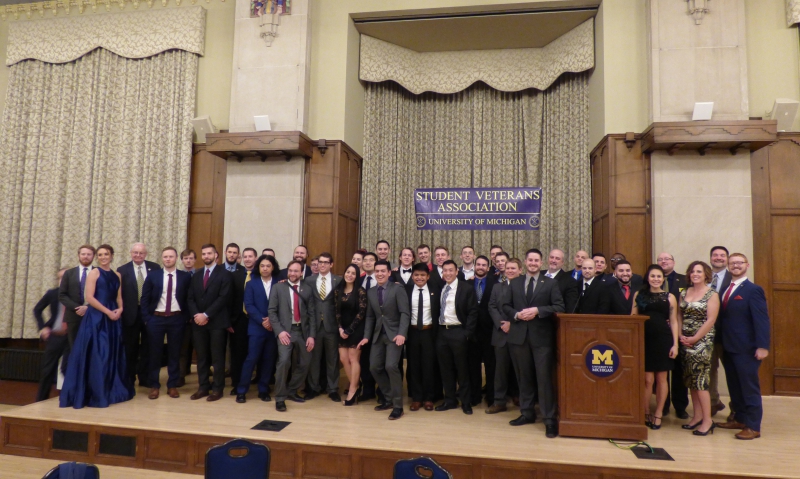
SVA celebrates the past, looks to the future
Air Force veteran Alyssa Carrillo initially rejected joining veterans groups because of a stigma she felt from other students. But when she transferred to the University of Michigan in Ann Arbor, she felt a connection with the Student Veterans of America (SVA) chapter there.
“I’ve found out that we are often times the first veteran they’ve actually known,” said Carrillo, who will complete UM’s dental hygiene program in May, just a few months after her first child is expected in February.”
Not only did she join the Student Veterans of America at the University of Michigan (SVAUM) chapter, she has taken on a leadership role as vice president. On Jan. 27, she was among more than 100 SVA members, alumni and supporters who celebrated the chapter’s 10th anniversary. SVA founder Derek Blumke was also on hand to hear guest speaker and current SVA National Board of Directors Chairman Peter Meijer.
The common bond among veterans was evident in the handshakes, hugs and boisterous conversations taking place around the room. The added identity of “student” that brought these veterans together is the enduring bond that transitions to the unique stories of the individuals.
“The SVA is the only place on campus where I can be my true self,” Army veteran and SVAUM Treasurer Matt Cline said. Although Cline had a difficult time academically in high school, he did well in the Army.
During, his first year of college he learned how to study and credits his involvement with SVA for his smooth transition. “It is very valuable having a group of people where my acceptance is based solely on my veteran status.”
Anthony Kourtakis was a seasoned student upon his return from battlefields in Iraq and the search and rescue operations of Hurricane Katrina. Kourtakis entered the Marine Corps in 2003 as an infantry rifleman with a bachelor’s in economics already under his belt, not wanting to be on the officer waitlist but more specifically desiring to fight the war after 9/11.
He sought out SVA as a way to foster friendships with other veterans on campus.
“I found my buddies,” said Kourtakis, referring to Blumke and other veterans on campus. “Belonging to the group provided much needed sanity checks and the unique perspective that only veterans can have.”
The American Legion is a longtime supporter of SVA. Among Legionnaires attending the weekend celebration was World War II veteran Frank Bernath, founding member of American Legion Post 502 in Elsie, Mich. Bernath served three years and two days in the Marine Corps, and was on his way from Guadalcanal to the Philippines when the war ended.
“I always felt safest when I was carrying a .38, a .45, and an M-1 carbine,” said the 92-year-old, who has owned no less than three dress blue uniforms in his lifetime – no pockets, pockets and gabardine. “The gabardine uniform costs the most,” he said, sitting up taller and adding that he would have worn it if he had known so many veterans would be at the event. The older Marine was there at the invitation of his grandson Matthew Bernath, an Army veteran and UM student who is active with the SVA chapter.
Bernath, who was only 16 when he joined the Marines, returned from war in 1946 to finish high school. When Post 502 was formed in 1947, Bernath said post members provided honors for two to three funerals a week because the government had by then begun to ship the bodies of fallen veterans home.
Transitions and support are no stranger to guest speaker Meijer. The Army veteran drew parallels between student veterans familiar with war past and present, whose return home included the need to fight for support from the federal government, with both the original GI Bill and the recent Forever GI Bill.
Meijer called the students to action. “Do your part to frustrate those who seek to divide and conquer; question simple narratives, whether on television or in your own minds; do your part to bridge the barriers that divide us; and seek to make what is foreign today, familiar tomorrow.”
Blumke, who received his bachelor’s, from UM in political science, currently studies the impact of technology on the workforce.
His early years setting up the organization and pushing for legislation on the GI Bill included working with then American Legion National Adjutant Bob Spanogle. Members of American Legion Post 460 helped him incorporate SVA in 2008.
Blumke’s early vision included many chapters, but admits that SVA has “grown far beyond the scope of any realistic vision that I had.” He remained involved with the chapter and the national organization as founder, board member, president and CEO through 2011. SVA now has more than 1,500 chapters that span all 50 states and four countries.
According to Blumke and Meijer, SVA will remain focused on student membership and legislation for veterans education. Students involved with SVA chapters work hand-in-hand with other veterans service organizations, and many choose to continue those relationships as they transition into careers and new communities.
Meijer encouraged students to look outward and reminds them that there is plenty of change yet to occur. “Just as student veterans have joined together throughout history to address and advance veteran education, they have the opportunity to join together once more and tackle the broader challenges facing our country.”
